Bred in Montana, the Montana Mountain Horse epitomizes the state’s spirit with its endurance and sure-footedness. Ideal for rough landscapes, it mirrors the core of Montana’s challenging yet stunning environment.
We will discuss the history and development of the Montana Mountain Horse, tracing its lineage back to Tom Eaton’s deliberate breeding efforts. You’ll learn about the standout qualities that make this breed a favorite among those who work with horses and ride for pleasure.
- Related article: Montana’s Diverse Wildlife
What makes the Montana Mountain Horse well-suited for the state’s landscape and tasks? You’ll see the careful criteria used to make sure these horses are the best in terms of performance and temperament.
Ready to discover more about this majestic animal? Let’s begin.
7 Key Takeaways on the Montana Mountain Horse
- Montana is home to the Montana Mountain Horse, a unique breed of horses crafted for the state’s rugged terrain by blending various lineages.
- The Montana Mountain Horse is known for its exceptional qualities, including a smooth walking gait, physical strength, and surefooted bravery.
- Breeding a Montana Mountain Horse requires meeting specific criteria and is a task of passion and precision.
- A direct descendant of Spanish horses, the Pryor Mountain Mustang roams the Pryor Mountains in Montana and Wyoming, representing living history.
- Characteristics of the Pryor Mountain Mustang include a natural ambling gait, a compact yet robust build, and adaptability to human interaction.
- The Pryor Mountains Wild Horse Range is a significant historical and natural site where visitors can observe wild horses.
- Equestrian activities in Montana offer unforgettable experiences. These activities include watching horses on Wild Horse Island and guided horseback riding in iconic national parks and ranches.
About the Montana Mountain Horse – the Montana Travler
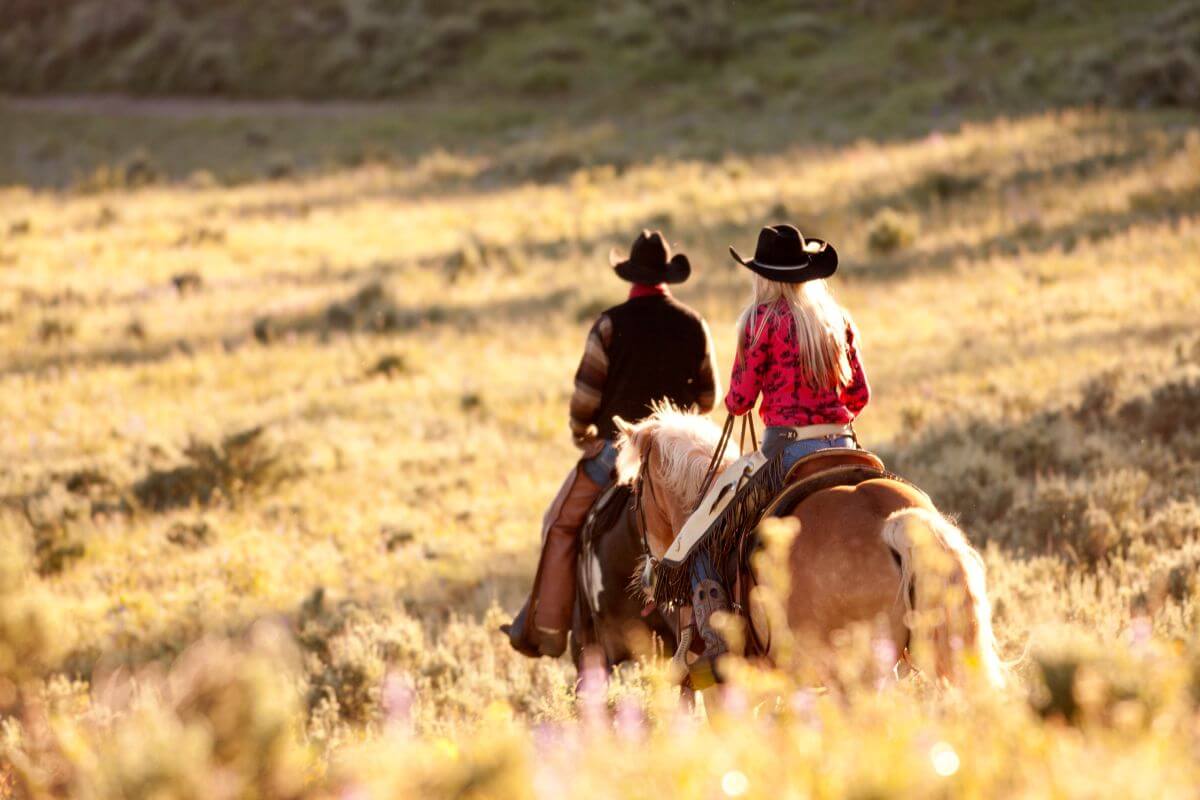
The Montana Travler is a horse breed well-suited to the harsh terrain of the American West. These horses have a long history of being used as dependable mounts in frontier life. They are known for their resilience and versatility, truly representing the state of Montana.
This section explores the captivating history, distinctive characteristics, and considerations for breeding this remarkable breed. From its origins on the vast plains to its role in modern horse riding pursuits, the Montana Travler horse continues to captivate enthusiasts even today.
Montana Mountain Horse History
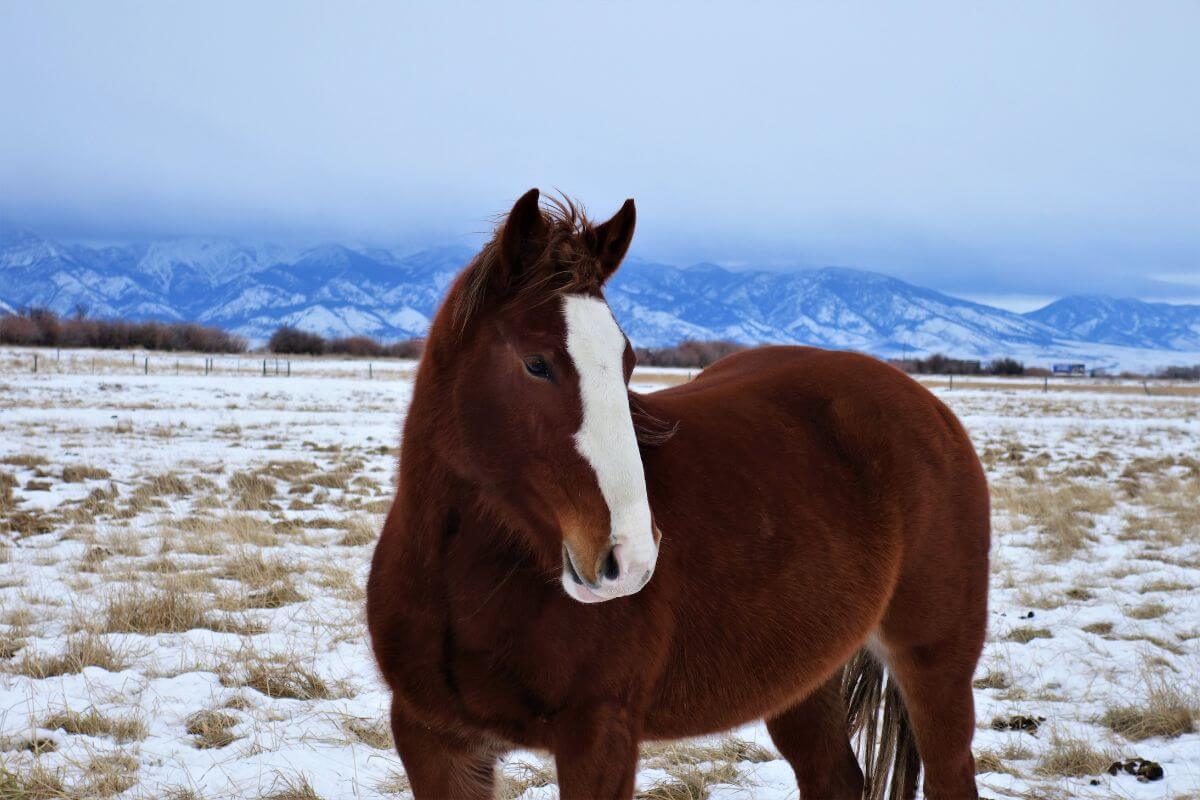
The Montana Mountain Horse or Montana Travler stands out as a perfect mountain horse. This breed resulted from the thoughtful breeding by Montana native Tom Eaton. Eaton’s quest in the 1930s to create an ideal horse led to the development of the Montana Travler by blending various horse lineages.
Tom Eaton dedicated 40 years to refining the qualities of his horses. His efforts were not in vain, culminating in discovering the truly exceptional Montana Travler. The breed combines the strengths of the Tennessee Walking, Morgan, American Saddlebred, Thoroughbred, and Hamiltonian horses.
This horse possessed a unique and remarkable quality that caught the attention of local horse enthusiasts. Recognizing the significance of his discovery, Eaton remarked, “The Montana Travler is the result of not only a great stallion but selective breeding over a period of many years.”
Tom Eaton took a significant step in 1979. He established a breed registry and association for the Montana Travler, encouraged by the positive reception from his peers and customers. This move ensured that registered horses were descendants of the Montana Travler and met strict criteria for conformation, gait, soundness, and temperament.
The recognition of the Montana Travler as a new breed by The American Horse Council in June 1984 marked a significant milestone. Subsequently, in 1989, Montana honored the breed by designating it as the official Centennial Horse.
The Montana Travler breed is highly valued and renowned for its unique qualities, making it an excellent choice for rugged and mountainous terrains. This recognition highlights its significance not just as a local favorite but as a breed that stands out for its exceptional attributes.
Montana Mountain Horse Characteristics
| Characteristic | Description |
|---|---|
| Height | The Montana mountain horse stands tall, ranging from 15.1 to 16.0 hands high. |
| Colors | The Montana mountain horse is available in solid colors, with white markings allowed on the face and legs. |
| Country of Origin | The Montana mountain horse is proudly from the United States of America, specifically Montana. |
| Common Uses | Montana mountain horses do everything from showing to endurance, jumping, ranch work, and pleasure riding. |
The Montana Mountain Horse is a breed like no other, born and bred in the rugged landscapes of Montana. But what sets them apart are their unique traits inherited from their ancestors, the Travlers:
- Running Walk Gait – The Montana Travler is a highly valued breed of horse popular among working horse enthusiasts and pleasure riders. Its smooth gait, exceptional endurance, cow sense, and gentle nature make it a great choice for various activities.
- Physical Strengths – The Montana Travlers are known for their deep chests, contributing to their endurance. They are also known for their narrow yet powerful build, perfect for navigating the roughest terrain.
- Stamina and Heart – Montana Travler horses are known for their impressive lineage, which includes a stallion that can run fast and has a remarkable gait. These horses have a great depth of heart, stamina, and a strong and willing temperament.
- Surefooted and Brave – Bred to tackle mountains, handle cattle, and be reliable pack horses, Montana Travlers are inherently courageous and surefooted. These traits are essential for their work and varied riding demands.
With its roots in the Montana Traveler breed, the Montana Mountain Horse is a testament to the symbiotic relationship between animal and environment.
Montana Mountain Horse Breeding

Breeding a Montana Mountain Horse is a task that requires both passion and precision. To keep the legacy of the Montan Travler alive, specific criteria must be met. Only horses with the A1 gene from the Montana Travler lineage and high-quality mares can be registered.
To be registered as a Montana Travler, horses must be at least three years old and trained for riding. Additionally, they must demonstrate the right conformation, disposition, and travel style, which should be true to the foundation sire. Registration is a serious step, needing the approval of the Montana Travler Horse Association.
Ray Knotts has taken a unique approach to creating the perfect mountain horse for Montana’s challenging landscapes. At 55, Knotts moved to the peaceful Flathead Valley from the busy southeast. He raised horses on his 40-acre ranch, located only 5 miles (8 km) from Kalispell.
His method involves crossing purebred Canadian horses with Missouri Fox Trotters. This blend aims to produce a horse with exceptional stamina, strength, and a smooth gait essential for navigating Montana’s rough terrains.
Knotts’ vision goes beyond breeding. He has invested in creating a top-notch facility on his ranch, including a custom-built 20,000-square-foot indoor arena and stables. Within these walls reside his hopes and dreams: three Canadian stallions and three Trotter mares, all part of the breeding program to enhance the mountain horse quality.
As Knotts puts it, “My dream is to get back to a horse that doesn’t need shoes.” His ultimate goal echoes the sentiments of many horse lovers in Montana. This is to have an improved mountain horse, sturdy and sure-footed, ready for any adventure.
Pryor Mountain Mustang
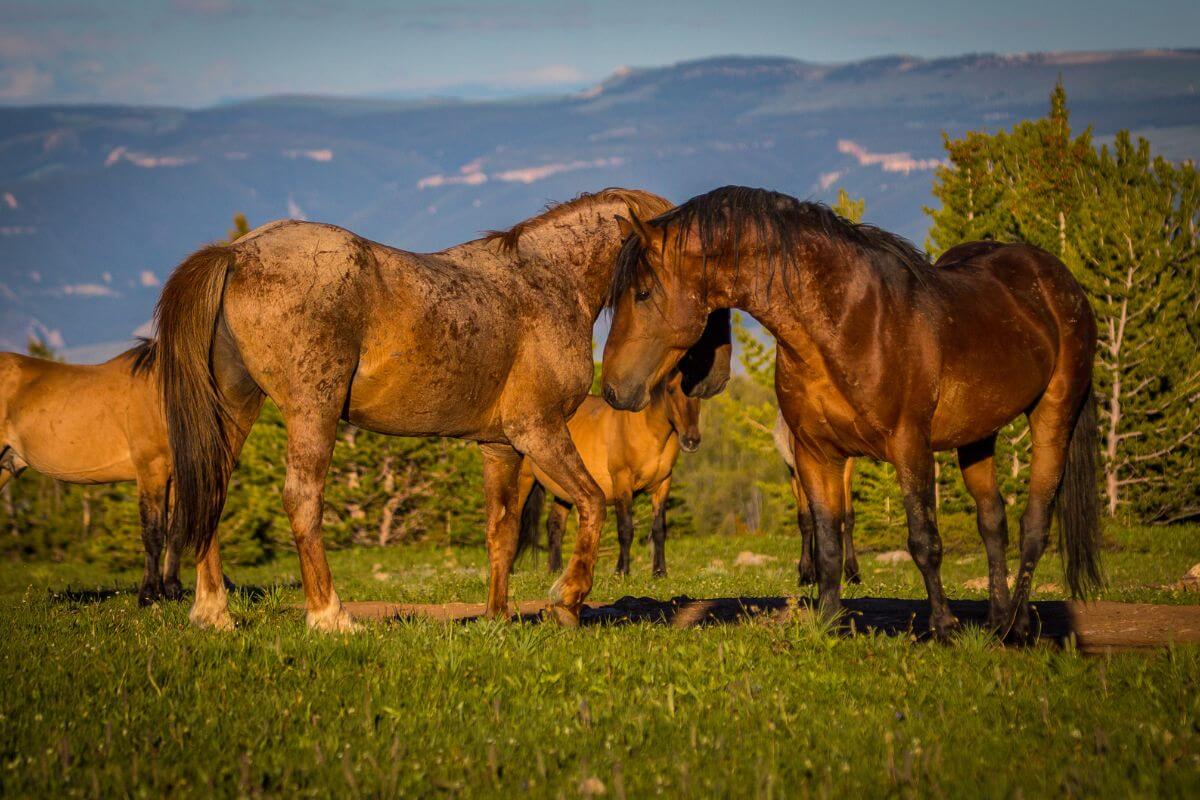
The Pryor Mountain Mustang is a living piece of history — a direct descendant of the Spanish horses brought to North America by the conquistadors.
These mustangs roam the rugged landscapes of the Pryor Mountains in Montana and Wyoming, showcasing their resilience and wild beauty. Let’s explore what makes them unique and their connection to the Montana mountains.
Pryor Mountain Mustang History
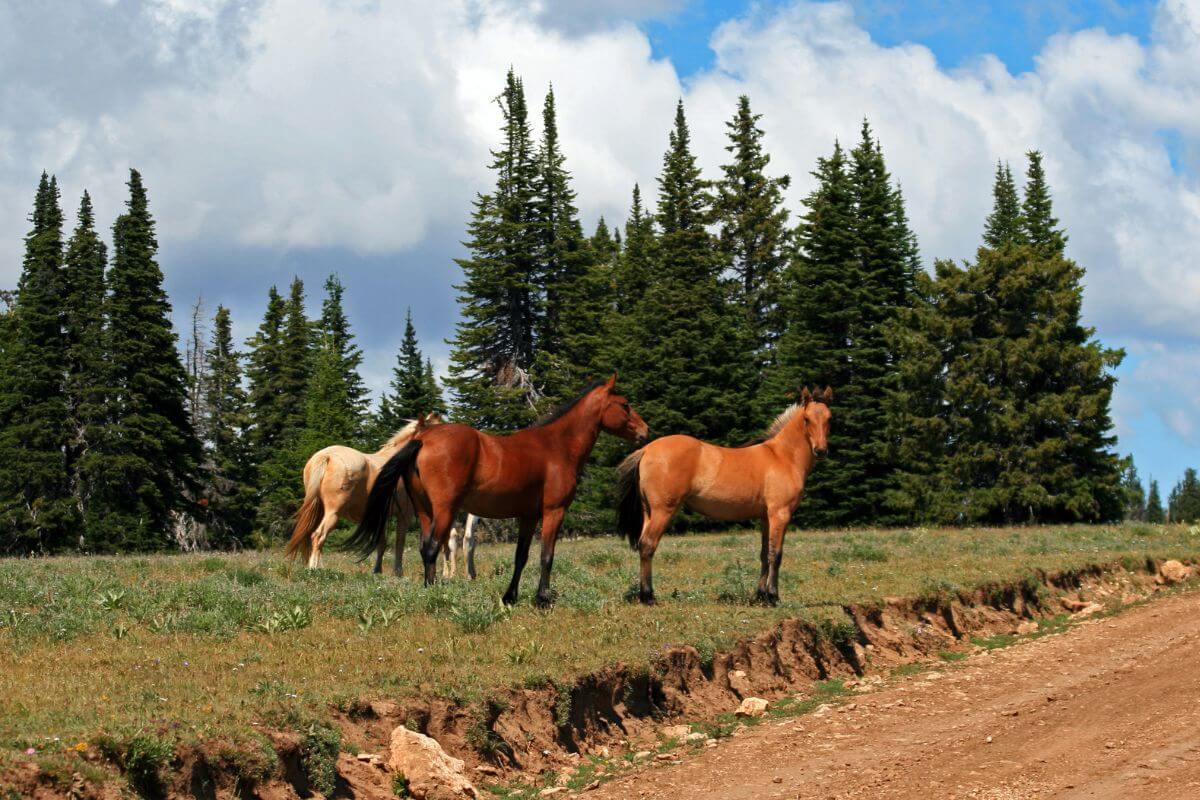
The Pryor Mountain Mustangs are more than just horses, they’re a piece of living history. This special breed is a descendant of the Colonial Spanish horses brought to the Americas. They are a subtype of Mustang that stands out for their genetic uniqueness. Based on DNA analysis, we know they have a direct line back to those original Spanish horses.
These incredible animals call the Pryor Mountains Wild Horse Range home. Here’s what makes their home so significant:
- Location – This range spans across the Pryor Mountains of Montana and Wyoming.
- Significance – Location of the only Mustang herd in Montana. It’s one of sixteen when you include Wyoming.
Their home isn’t just any piece of land. It’s a place protected by law to ensure the Mustangs can live as they have for centuries. The Wild and Free-Roaming Horses and Burros Act of 1971 protects these animals, and the Bureau of Land Management (BLM) monitors them closely to ensure the herd stays at a healthy size of 120 Mustangs.
Here’s a quick look at the timeline of the Pryor Mountain Mustangs in the Pryor Mountains:
- Early 1700s – Feral horses are noted in the Pryor Mountains, possibly even earlier.
- Late 1800s – The population booms, with thousands of feral horses roaming the area.
- September 9, 1968 – The Secretary of the Interior established the Pryor Mountain Wild Horse Refuge, securing their future home.
This refuge isn’t just a place, it’s a living testament to the history of these Mustangs. It’s a place where they can run free, just as they have for generations.
Pryor Mountain Mustang Characteristics
Pryor Mountain Mustangs stand out as relatively small yet incredibly sturdy horses. They are known for their impressive strength, steady footing, and endurance when tamed. They have a distinctive and easygoing way of walking in their natural state.
Pryor Mountain Mustang traits make them fascinating in the wild and excellent partners for various tasks when brought into human environments. Let’s take a look at the physical characteristics that define the Pryor Mountain Mustang:
| Characteristic | Description |
|---|---|
| Height | Pryor Mountain Mustangs are 13 to 15 hands high (52 to 60 inches, 132 to 152 cm), with an average of 14 to 14.2 hands (56 to 58 inches, 142 to 147 cm). |
| Weight | Pryor Mountain Mustangs typically weigh between 700 to 800 pounds (320 to 360 kg) in the wild, with the potential to be heavier in captivity. |
| Colors | Pryor Mountain Mustangs come in many solid colors, from bay and black to chestnut and more, including buckskin and pinto variations. |
| Body | Pryor Mountain Mustangs are characterized by a heavy body supported by strong bones, especially in their heavy and often curly winter coat. |
| Head | Pryor Mountain Mustangs feature a convex or straight head shape, wide-set eyes, hooked ears, and small, crescent-shaped nostrils. |
| Teeth | Pryor Mountain Mustangs’ front teeth meet evenly and have a unique lip and nostril shape. |
| Neck | Pryor Mountain Mustangs’ neck is of medium length. |
| Shoulders | Pryor Mountain Mustangs’ shoulders are long and sloping. |
| Withers | Pryor Mountain Mustangs have prominent withers. |
| Chest | Pryor Mountain Mustangs’ chest is of medium to narrow width. |
| Croup | Pryor Mountain Mustangs’ croup is generally sloped. |
| Tail-Set | Pryor Mountain Mustangs have a low tail-set. |
| Hooves | Pryor Mountain Mustangs have large and very hard hooves. |
In addition to their physical characteristics, some Pryor Mountain Mustangs have a natural ambling gait. This, along with their intelligence, strength, and stamina, makes them ideal for various tasks once they are accustomed to human interaction.
However, it’s important to note that, like all feral horses, Pryor Mountain Mustangs are initially distrustful and easily spooked around humans. Yet, with patience and the establishment of trust, they can form strong social bonds with individuals.
These horses exhibit a calm temperament and remain alert on trails once trained, showcasing their adaptability and the depth of their bond with their riders.
Pryor Mountains Wild Horse Range
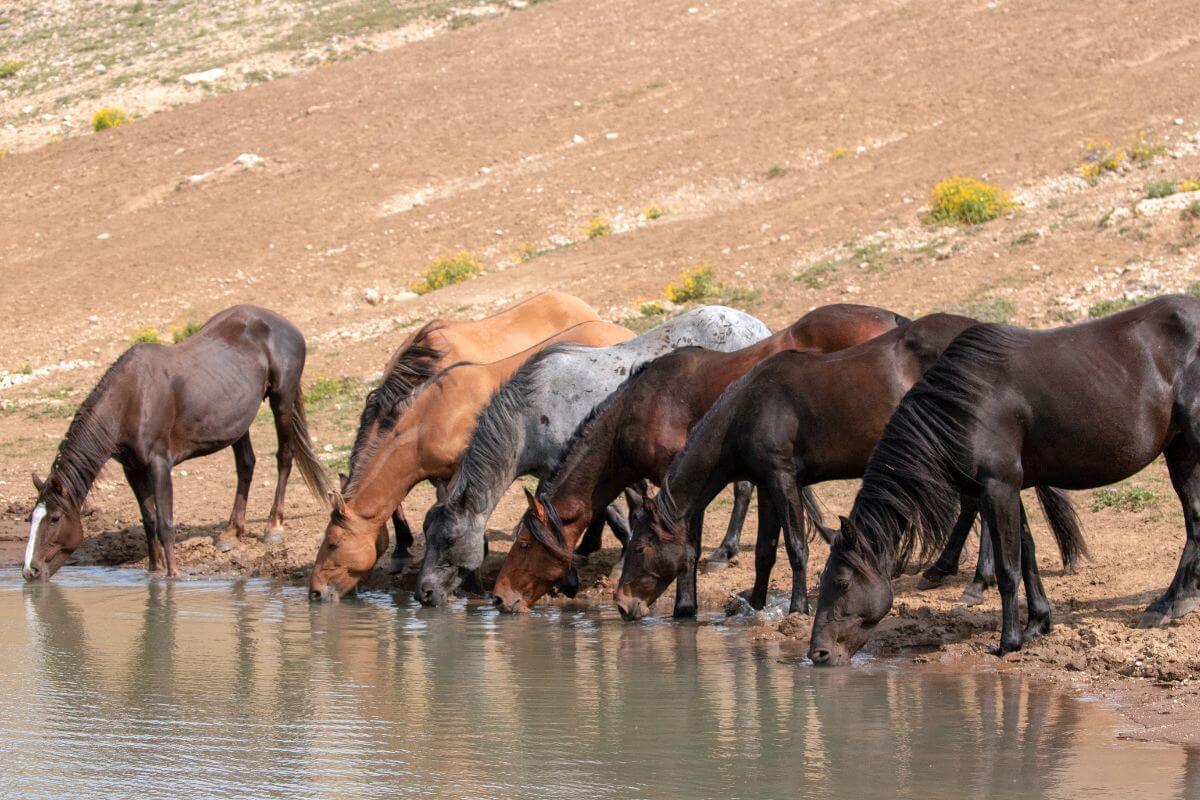
The Pryor Mountains Wild Horse Range is a special place where you can see feral horse herds up close. This area has recently become more popular with tourists from everywhere who want to see these wild horses in their natural homes.
This range is different from most places. It’s one of only four areas in the country set aside for wild horses and burros, meaning the land is mainly used for these animals. But it’s not just about the horses. The Pryor Mountain Wild Horse Range is also about wide-open spaces and the beauty of nature.
Here are some key points about the remarkable Pryor Mountains Wild Horse Range:
- Location – The Pryor Mountains Wild Horse Range sits in the southeastern part of Carbon County, Montana, and the northern part of Big Horn County, Wyoming. It’s not too far from big cities like Billings, Montana, and Lovell, Wyoming.
- For Visitors – People can visit every year to watch the horses. It’s a great spot for nature lovers to see these famous wild animals from a safe distance.
Today, the Pryor Mountains Wild Horse Range covers more than 38,000 acres of land dedicated to preserving the heritage and beauty of these unique horses.
Equestrian Activities in Montana
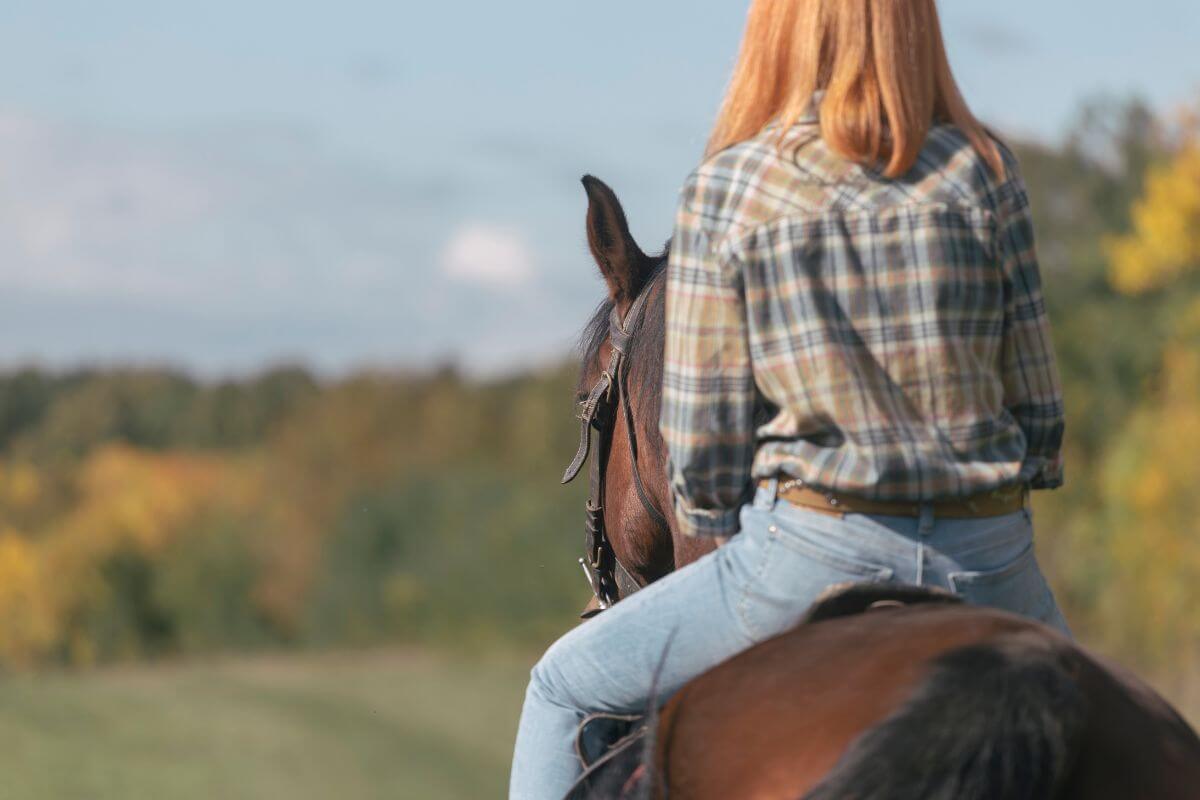
Montana offers a dream-like setting for horseback riding, with its vast landscapes and mountainous terrains. This section dives into the heart-pounding joy of equestrian activities in the state, highlighting the perfect fusion of nature and adventure.
Let’s explore how horse riding in Montana isn’t just a ride. It’s an experience that connects you deeply with the state’s soul and lets you witness its beauty in a way that’s reserved for a lucky few.
Best Areas for Horse Watching in Montana
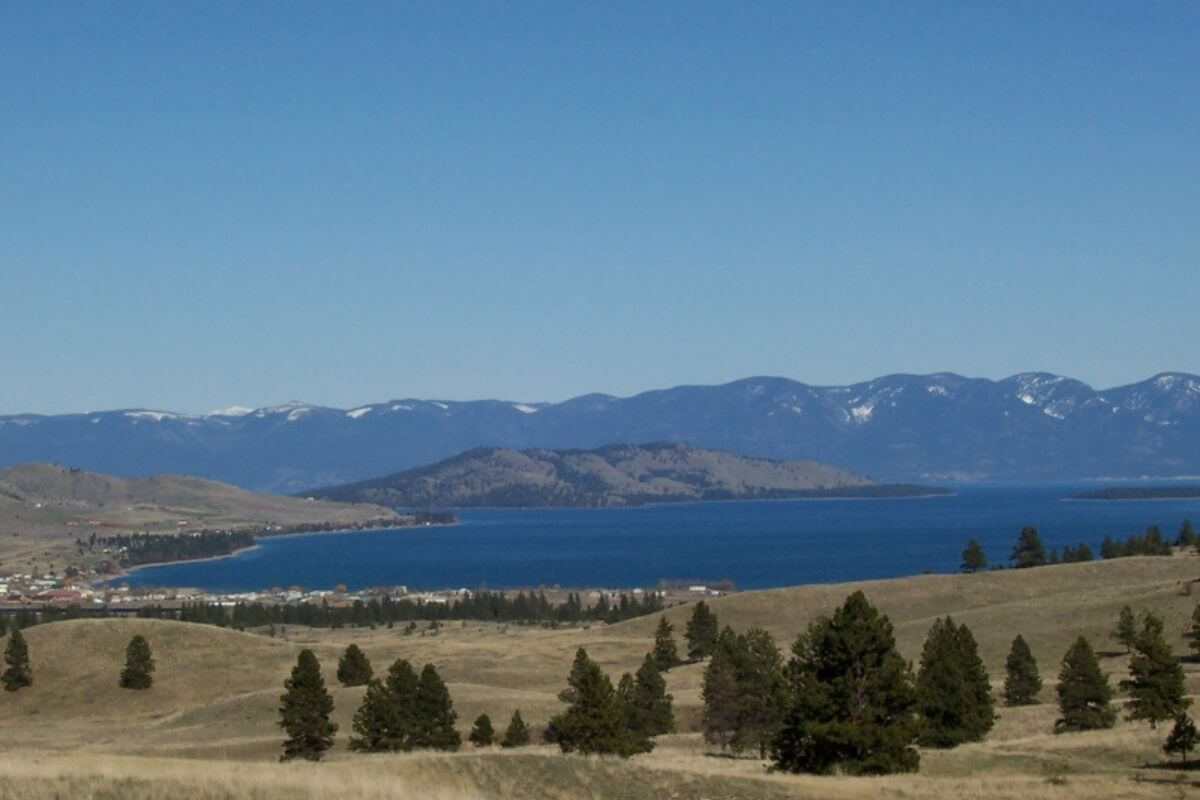
Watching horses in Montana is not just about seeing them run free. It’s about stepping into history and nature all at once. Aside from the aforementioned Pryor Mountains Wild Horse Range, there is another place in Montana worth visiting for its wild horses.
Wild Horse Island in Flathead Lake is where you can watch horses living much as they did in the past. Surrounded by Flathead Lake waters, this island offers more than just a glimpse of horses. It’s a sanctuary for a few wild descendants of the horses that the Salish-Kootenai people once grazed here.
Here’s why Wild Horse Island is a top spot for horse watching:
- Rich History – The connection to the Salish-Kootenai people adds a layer of historical richness to the horse-watching experience.
- Wildlife and Scenery – Apart from horses, the island’s lush pine forests, beautiful trails, and a chance to see rare plants make it a paradise for nature lovers. These horses share the island with various wildlife, including bald eagles and bighorn sheep.
- Island Adventure – Accessible only by boat, the adventure of reaching the island adds to its allure.
For those who love horses and nature, this 2,200-acre island is a dream. It’s not just about the horses, it’s about the whole experience of getting there and what you see.
Best Places for Horseback Riding in Montana
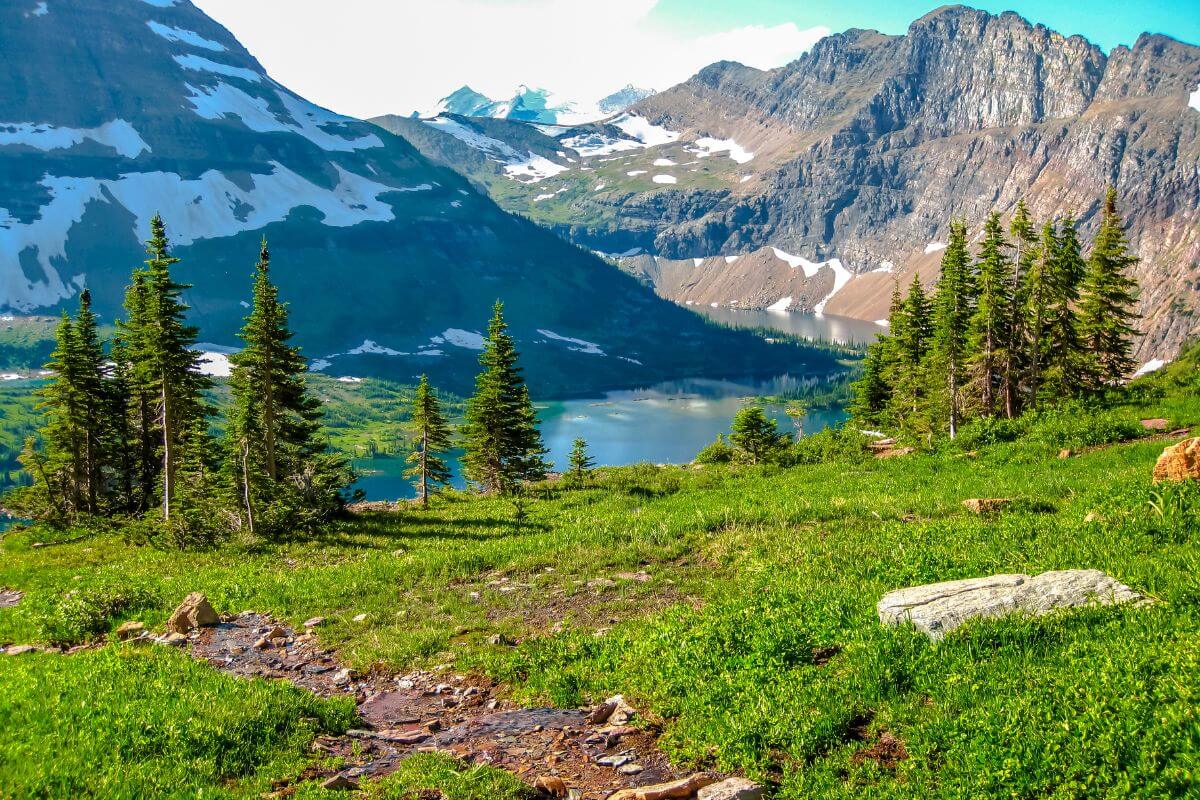
The options for horseback riding in Montana are as vast as the Big Sky Country. Explore the state’s most beautiful landscapes on horseback, with the wind in your hair and a sense of freedom like never before.
Here are some of the top places in Montana that offer guided horseback adventures, perfect for both beginners and experienced riders:
- Glacier National Park – Guided horseback rides allow you to explore Many Glacier, Lake McDonald, and Apgar within the park’s boundaries. Swan Mountain Outfitters’ drop camp services are a great option for those looking to venture into the backcountry without heavy backpacks. With their stock, you can enjoy the backcountry experience with a lighter load. Just remember, a backcountry permit and some planning ahead are necessary.
- Yellowstone National Park – Yellowstone National Park is also a must-visit for horse lovers. Licensed outfitters can take you on day trips or longer backcountry adventures, offering a unique perspective on Yellowstone’s geysers, wildlife, and vast meadows.
- Lone Mountain Ranch – Lone Mountain Ranch in Big Sky is ideal for a trail ride with a taste of history. For over a century, they’ve been guiding horseback tours, allowing visitors to explore off-the-beaten-path parts of the Yellowstone backcountry.
- Jake’s Horses – Offering trail rides all year round, Jake’s Horses lets you explore Montana’s mountains at your own pace. They offer short one-hour rides or a full-day adventure with their extensive trail systems, spanning hundreds of square miles across National Forests and Yellowstone.
- 320 Guest Ranch – With tours covering over 2,000 miles of trails (about 3,218.7 km) each year, 320 Guest Ranch offers the chance to see a variety of landscapes, from meadows to mountain peaks. Keep your eyes peeled, as wildlife sightings are common, adding an extra thrill to your ride.
Each place offers a unique horse recreation, showcasing the diversity and beauty of Montana’s outdoors. Whether you’re a seasoned rider or your first time in the saddle, these locations will surely create unforgettable memories.
Montana Mountain Horse Final Thoughts
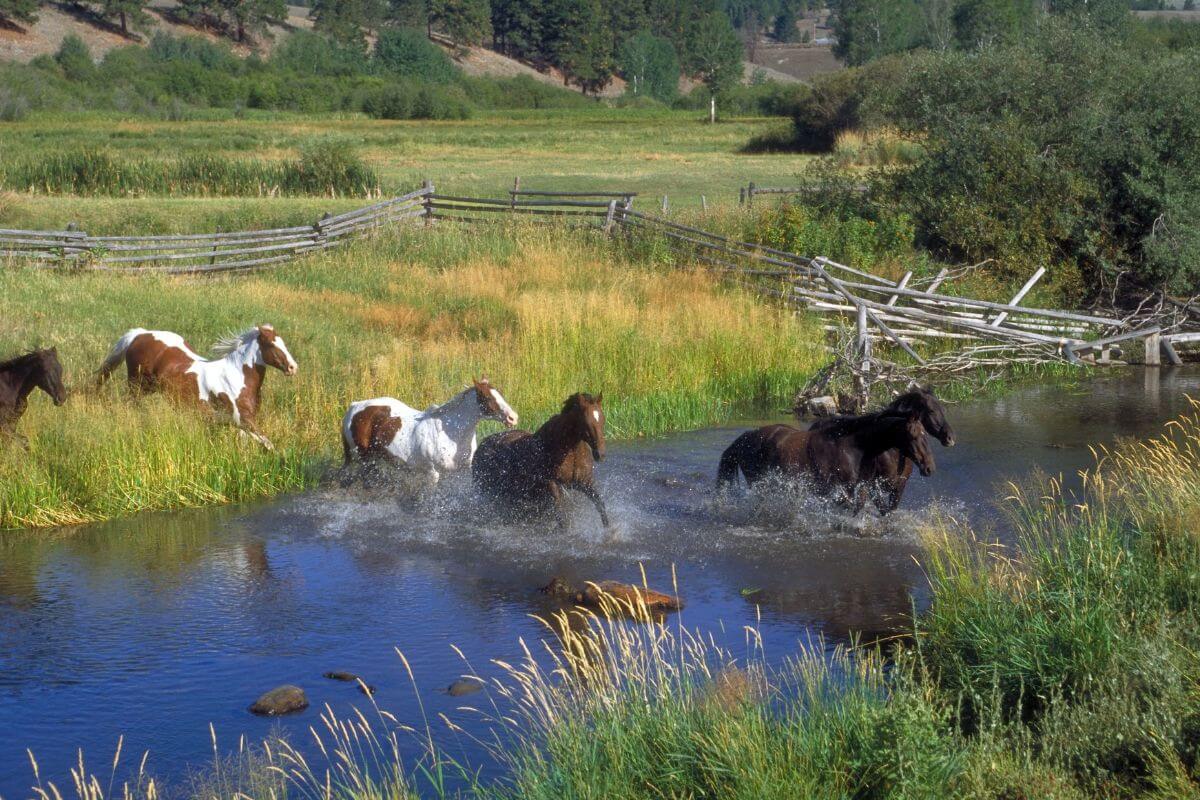
The Montana Mountain Horse and the Pryor Mountain Mustang are living testaments to Montana’s rich equestrian heritage. One is crafted for the state’s rugged terrains, and the other is a direct descendant of history. However, both these unique breeds symbolize the deep connection between horses and Montana’s vast, wild landscapes.
Breeding and preserving Montana’s exceptional horses require knowledge and a deep passion for their unique qualities and the stories they carry. As we reflect on the Montana Mountain Horse and the Pryor Mountain Mustang, we’re reminded of the importance of heritage, nature, and the ongoing effort to keep these legacies alive.
Whether watching wild horses in their natural sanctuary or riding a horse bred specifically for Montana’s challenges, the experience is one that holds itself into your memory.
The state’s horses invite us to appreciate the beauty and history intertwined in every hoofbeat. This urges us to protect and cherish these remarkable creatures and the lands they call home.
Montana Mountain Horse Guide FAQs
1. Are There Any Wild Horses in Montana?
There are wild horses in Montana. While not as common as in some other states, Montana is home to several populations of wild horses, particularly in remote areas such as the Pryor Mountains.
2. Can You Capture Wild Horses in Montana?
Congress protects wild horses in Montana from capture, branding, harassment, or death. They are considered integral parts of the natural system of public lands where they roam. Therefore, capturing wild horses in Montana requires adherence to specific regulations and guidelines to ensure their protection and welfare.
3. Why Is Montana Called Hungry Horse?
Montana is not called Hungry Horse. Instead, it is the name of a town and reservoir in the state. The name “Hungry Horse” originates from a legend about a hungry horse stranded near the Flathead River’s South Fork and seen eating the bark of trees. The name stuck and was eventually applied to the town and the nearby reservoir.
4. Are There Mustangs in Montana?
There are Mustangs in Montana. Mustangs are feral horses that are descendants of domesticated horses brought to North America by Spanish explorers and settlers. They roam freely in various regions across the United States, including parts of Montana.
5. Where Is the Best Place to See Wild Horses in Montana?
One of the best places to see wild horses in Montana is the Pryor Mountains Wild Horse Range, in the south-central part of the state near the Montana-Wyoming border. This area is known for its population of wild Mustangs, which have roamed the rugged landscape for centuries
Learn more about the state of Montana through the articles below:

